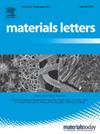短停留时间氧化和压力驱动碳化对沥青基碳材料微观结构和电化学性能的影响
IF 2.7
4区 材料科学
Q3 MATERIALS SCIENCE, MULTIDISCIPLINARY
引用次数: 0
摘要
在这项研究中,煤焦油沥青(CTP)在不同温度下进行短停留时间空气氧化,然后在压力下进行热处理,以获得绿色焦炭,目的是促进介相的发展。然后,将绿色焦炭碳化,制备锂离子电池(LIB)的负极材料。研究了碳化产品的微观结构与电化学性能之间的相关性。结果表明,短停留时间氧化有利于沥青醚的 OH 和 O 形成氢键。压力驱动增强了绿色焦炭碳层的取向,从而导致后续碳化产物的石墨烯层尺寸增大。碳化产物用作锂离子电池阳极材料时,在电流密度为 2 A/g 时可显示出 278 mAh/g 的高可逆比容量,循环 1000 次后性能稳定。因此,适当的氧化时间和低温下的压力驱动对碳化过程中碳层的生长至关重要。本文章由计算机程序翻译,如有差异,请以英文原文为准。
Effects of short residence time oxidation and pressure-driving carbonization on microstructure and electrochemical performance of pitch-based carbon materials
In this work, coal tar pitch (CTP) is subjected to short residence time air oxidization at varying temperatures, followed by heat treatment under pressure to obtain green cokes with the aim of promoting mesophase development. Then, the green cokes are carbonized to prepare anode materials of lithium-ion batteries (LIBs). The correlation between the microstructure of the carbonized products and the electrochemical performance is investigated. The results reveal that short residence time oxidation facilitates the formation of hydrogen bonds of OH and O of the ether of the pitch. The pressure driving enhances the orientation of the carbon layer of the green cokes, which leads to increased graphene layer size of the subsequent carbonization product. When used as LIB anode materials, the carbonization product displays a high reversible specific capacity of 278 mAh/g at the current density of 2 A/g with stable cycling performance after 1000 cycles. Therefore, appropriate oxidation time and pressure driving at low temperatures are crucial for the growth of the carbon layer during the carbonization.
求助全文
通过发布文献求助,成功后即可免费获取论文全文。
去求助
来源期刊

Materials Letters
工程技术-材料科学:综合
CiteScore
5.60
自引率
3.30%
发文量
1948
审稿时长
50 days
期刊介绍:
Materials Letters has an open access mirror journal Materials Letters: X, sharing the same aims and scope, editorial team, submission system and rigorous peer review.
Materials Letters is dedicated to publishing novel, cutting edge reports of broad interest to the materials community. The journal provides a forum for materials scientists and engineers, physicists, and chemists to rapidly communicate on the most important topics in the field of materials.
Contributions include, but are not limited to, a variety of topics such as:
• Materials - Metals and alloys, amorphous solids, ceramics, composites, polymers, semiconductors
• Applications - Structural, opto-electronic, magnetic, medical, MEMS, sensors, smart
• Characterization - Analytical, microscopy, scanning probes, nanoscopic, optical, electrical, magnetic, acoustic, spectroscopic, diffraction
• Novel Materials - Micro and nanostructures (nanowires, nanotubes, nanoparticles), nanocomposites, thin films, superlattices, quantum dots.
• Processing - Crystal growth, thin film processing, sol-gel processing, mechanical processing, assembly, nanocrystalline processing.
• Properties - Mechanical, magnetic, optical, electrical, ferroelectric, thermal, interfacial, transport, thermodynamic
• Synthesis - Quenching, solid state, solidification, solution synthesis, vapor deposition, high pressure, explosive
 求助内容:
求助内容: 应助结果提醒方式:
应助结果提醒方式:


